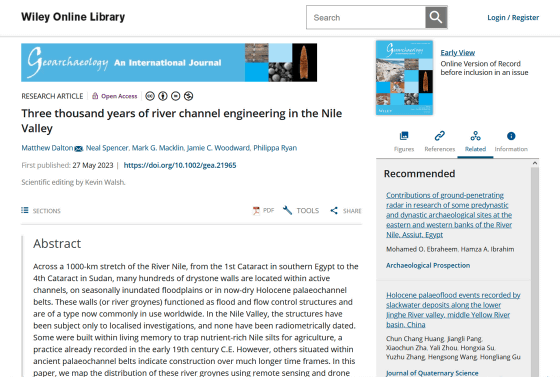It turns out that the ancient structure built along the Nile was ``the world's oldest system to control the flow of the river''

Three thousand years of river channel engineering in the Nile Valley - Dalton - Geoarchaeology - Wiley Online Library
https://doi.org/10.1002/gea.21965

Walls along River Nile reveal ancient forms of hydraulic engineering
https://www.uwa.edu.au/news/Article/2023/June/Walls-along-River-Nile-reveal-ancient-form-of-hydraulic-engineering
Ancient Structure Along River Nile Is Oldest Hydraulics System of Its Kind : ScienceAlert
https://www.sciencealert.com/ancient-structure-along-river-nile-is-oldest-hydraulics-system-of-its-kind
A groyne is a river control structure built to control sediment and water flow, often constructed as a jetty projecting vertically from the river bank. Drains have effects such as slowing the erosion process during floods and are still found in many rivers today.

A research team led by Dr. Matthew Dalton of the University of Western Australia's Faculty of Humanities investigated the area around the Nile River in the area called
Many of the discovered dykes were found in the ancient Nile basin, which has already dried up due to past climate change, and in the river bed of the Nile. Some of them were found in 19th-century traveler's records and archives of aerial photographs taken by the Royal Air Force in the first half of the 20th century, but were already sunk to the bottom of the Aswan High Dam. matter.
Below is a picture of the water system actually identified by the research team. You can see that there are various types of sluice structures, from thick stones arranged horizontally to flat stones stacked vertically.

Regarding the role of the water system created by the ancient Nubians, the research team ``blocks the fertile soil brought by the Nile River'', ``irrigates the land'', ``prevents erosion of the embankment'', ``seasonal It is thought that there were various uses such as protecting the surrounding area from violent floods, creating artificial pools for fishing, and preventing wind-blown sand from damaging crops.
Although the practice of building dykes along the Nile has been thought to be relatively modern, dating back to the early 19th century, there were also dykes in Nubia that are believed to be even older. Ancient Nubians living along the Nile River were known to have built canals and ports, but the water system was never independently dated.
It is difficult to determine the exact age of submerged dikes, but

'These walls trapped fertile sediment during the annual Nile floods, allowing crops to be grown on reclaimed land without artificial irrigation,' Dalton said. We can see that the indigenous people of the region, the Nubians, and the inhabitants of the city built by the pharaohs of the New Kingdom of Egypt , shaped the landscape.”
Climate change in the past has also altered the course of the Nile, with some tributaries drying up completely, devastating dykes, and others sinking to the bottom. However, when the research team interviewed a Sudanese farmer, the water system continued to be built even in the 1970s, and some of the land created by the water system was still cultivated even today. matter.
The picture below shows a water system made in the 20th century, and you can see that crops are grown in the adjacent landfill. 'This incredibly long-lived irrigation technology has played a vital role in growing food and thriving communities in Nubia's harsh wilderness for more than 3,000 years,' Dalton said. said.

In addition, near the ancient temple of Soleb on the west bank of the Nile, it was also found that there is a wall with a total length of 700 m made of rocks weighing 100 kg in the Nile. Built into the river, these walls are thought to have created a calmer channel and improved access for ships.
Further investigation is needed to determine the exact age of these structures, but 3000-year-old water dikes have also been found nearby, suggesting they may be just as old. 'These monumental water features facilitated the long-distance movement of resources, armies, people and ideas along the Nile and helped connect the peoples of ancient Egypt and Nubia,' Dalton said. said.
Related Posts:
in Science, Posted by log1h_ik







